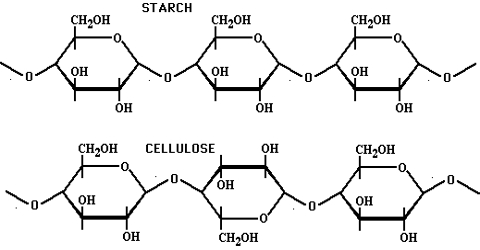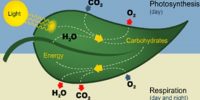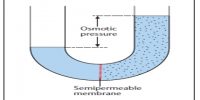Cellulose and starch are similar polymers that have the same glucose-based repeat units and are made of same glucose, and monomer. The main difference between them is humans can eat starch but are not able to digest cellulose. The key difference is in the linkage of the glucose bonds. Cellulose has beta 1,4 linkage while starch has alpha 1,4 linkage. Cellulose occurs in nature as pure cellulose, lignin or hemicellulose. Whereas starch occurs in the form of amylopectin and amylose. Cellulose is not fit for human consumption whereas starch can be consumed by humans.
Difference between Starch and Cellulose:
Starch
- Starch is formed by the glycosidic linkage between α (1→4) and α (1→6) and it is a polymer of α-D glucose. C1-O-C4 looks like “V”. The position of the -OH group enables the glucose rings to either form straight chains or branch out to create helical structures and multiple coils.
- Starch is not a single polymer. Starch is formed by the simple chained poly glucose, amylose, and branched-chain poly glucose, amylopectin. It is a coiled and branched molecule containing side chains that can be rapidly hydrolyzed to provide energy.
- Starch is the stored carbohydrate of the cell, which is semi-soluble in water. It is a large molecule that is insoluble in water (due to strong London forces between molecules) therefore has no osmotic effect on cells.
- It is easily digestible and is used as food animals. It is also a compact polysaccharide, therefore, it contains a lot of glucose in a small space in the cell (so it is an efficient source of energy).
- It is a non-crystalline powder
- Easily hydrolyzed.
- Forms blue color with iodine.
- The Starch is less weak than cellulose and can be dissolved in warm water.
Starch is one of the most common types of carbohydrates ideal for human consumption. When used for industrial purposes, starch is used for the production of whiskey, beer, and biofuel.

Cellulose
- Cellulose is formed by β (1→4) glycosidic linkage and it is a polymer of β-D glucose C1-O-C4 looks like “A”-“V”-“A” alternatively. It is made up of 1 type of beta-glucose units linked together by glycosidic bonds.
- Cellulose is a simple chain of poly glucose. Cellulose chains are joined together by hydrogen bonds to form cellulose microfibrils which are arranged in a matrix of hemicelluloses.
- Cellulose is the structural element which forms plant body and fibers. It is totally insoluble in water. It is available as lignin, hemicellulose, and pure cellulose.
- It is not digestible and so is not eaten a portion of food. It is used in producing cloth, furniture, etc. Only specific animals such as ruminants and termites are capable of digesting cellulose due to the unique microorganisms present in their gut.
- It can be found in the form of fibers, and solid sheets
- Not easily hydrolyzed.
- No such change occurs with iodine.
- Cellulose is stronger than starch and is insoluble in water.
Cellulose is widely used in manufacturing paper and paperboard. In other industries, it is also used in making cotton and wood pulp.
In starch, the position of glucose repeat units is in the same direction whereas, in cellulose, each successive glucose unit is rotated 180 degrees. Some of the uses of cellulose are in the derivation of rayon, cellophane, etc. Commercially it is used as the main component in the paper industry as well as in the making of cloths such as linen and like cotton.















